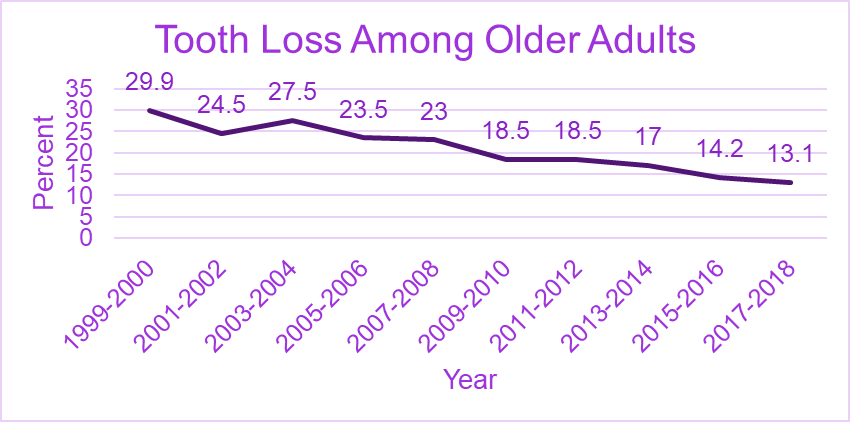Oral health is important for everyone as it affects the ability to smile, eat, taste and communicate effectively.
Oral health is important for everyone as it affects the ability to smile, eat, taste and communicate effectively. By taking care of the teeth and gums, one can improve their overall quality of life. People should seek proper support in preventing and treating oral health conditions throughout their lifetime.
Thanks to improvements in prevention and treatment efforts, the number of Americans with tooth loss has gone down over the last few decades.1,3 Between 1999 and 2000, just under 30% of adults aged 65 and older experienced complete tooth loss. More recent data shows that between 2017 and 2018, that percentage dropped to about 13%.2
The National Health and Nutrition Examination Survey (NHANES) found that 3.8% of adults between ages 20 and 64 from 1999 to 2004 had no remaining teeth.1 In more recent years, that percentage has dropped to 2.2%.1 According to the Centers for Disease Control and Prevention (CDC), this trend is expected to continue.4
Figure 1. Tooth loss among older adults in the U.S.

Source: https://www.cdc.gov/nchs/data/databriefs/db368-tables-508.pdf#page=4
Preventive care is still important for oral health
Although the prevalence of tooth loss is declining, there are still significant disparities among groups who experience tooth loss and gum disease.3,4,5 For example, older adults, current smokers, those with lower incomes and those with less education are more likely to experience partial or total tooth loss.1 Tooth loss can also vary by sex, age and race.1
Fortunately, many U.S. communities have taken steps to help address these disparities. Community water fluoridation, for example, has proven to prevent tooth decay by up to 40%.3 School-based dental sealant programs, which primarily serve low-income families, can prevent up to 80% of tooth decay.3
What can you do to prevent tooth loss?
More people may be keeping their teeth, but they’ll need preventive care as they age, such as routine teeth cleanings, to keep their teeth healthy. It's important to seek both professional and personal care to maintain oral and overall health.
According to the CDC, any person can help prevent tooth loss by:
- Treating tooth decay
- Addressing gum disease
- Avoiding alcohol and tobacco use
- Choosing nutrient-dense foods3
Sources:
- Tooth Loss in Adults (Age 20 to 64). National Institute of Dental and Craniofacial Research (nih.gov)
- NCHS Data Brief, Number 368, June 2020 (cdc.gov)
- U.S. Department of Health and Human Services. Healthy People 2020: Oral health. 2019.
- Gooch BF, Eke PI, Malvitz DM. Public health and aging: Retention of natural teeth among older adults—United States, 2002. MMWR Morb Mortal Wkly Rep 52(50):1226–9. 2003.
- Centers for Disease Control and Prevention. Oral health surveillance report: Trends in dental caries and sealants, tooth retention, and edentulism, United States, 1999–2004 to 2011–2016. 2019.
- Eke PI, Dya BA, Wei L, Slade GD, Thornton-Evans GO, Borgnakke WS, et al. Update on prevalence of periodontitis in adults in the United States: NHANES 2009 to 2012. J Periodontol 86(5):611–22. 2015.
- Centers for Disease Control and Prevention. Current cigarette smoking among adults in the United States. 2019.
The information contained herein is for informational and educational purposes only. This information is not a substitute for professional medical advice and if you have questions regarding a medical condition, regimen or treatment you should always seek the advice of a qualified health care provider. Never disregard or delay seeking medical advice from a qualified medical professional because of information you have read herein.
Current (57)
Unfiltered (68)
- Articles by date
- March 2024 (4)
- February 2024 (2)
- January 2024 (2)
- December 2023 (3)
- November 2023 (3)
- October 2023 (2)
- September 2023 (3)
- August 2023 (1)
- July 2023 (2)
- June 2023 (1)
- May 2023 (1)
- April 2023 (3)
- March 2023 (2)
- February 2023 (1)
- January 2023 (4)
- December 2022 (2)
- November 2022 (2)
- October 2022 (1)
- September 2022 (2)
- August 2022 (1)
- July 2022 (6)
- June 2022 (1)
- May 2022 (2)
- April 2022 (3)
- March 2022 (1)
- February 2022 (1)
- January 2022 (2)
- November 2021 (3)
- October 2021 (1)
- September 2021 (2)
- August 2021 (1)
- July 2021 (3)
- Categories
- Featured Articles (1)
- GEHA Connection Dental Network News (47)
- GEHA Connection Dental Network Provider Newsletter (19)
- Vendor Outage Notice (1)